Still Showing Low-Stock Products in Your Recommendations? Here’s a Must-Do Fix for 2025
There is a very high chance that low-stock product recommendations are tanking your conversions — and your retail brand.
Why? Recommending products that you don’t have enough of means:
- Frustrated shoppers
- Wasted merchandising and marketing effort (and spend!)
- Inefficient inventory turnover
- Revenue loss
And this inventory blindness is more common than you think it is.
In this post, we lay out everything you need to know about real-time product recommendations, where you’re likely to find them hidden, and how you can make sure you are pushing inventory-aware product recommendations across your Shopify store.
What Are Low-Stock Product Recommendations?
These happen when your store’s recommendation engine promotes products (or variants like sizes or colors) that are nearly sold out. You’ll typically see them in upsell carousels, “You May Also Like” sections, and personalized email suggestions — all pushing products that can’t convert.
Especially if your merchandising strategy centers around your bestsellers without factoring in other inventory optimization metrics. And it happens, a lot, as most recommendation engines use popularity or shopper behavior but ignore real-time inventory.
What’s the Role of Inventory Management in Product Recommendations?
Smart product recommendations aren't just about popularity or past performance. They also depend on what's in stock. That’s where inventory management plays a critical role.
If your recommendation engine doesn’t consider stock levels, low inventory thresholds, or variant availability, it risks promoting products your shoppers can’t buy. This includes showing items with only one size left or recommending bestsellers that are already sitting at dangerously low stock quantities.
Even a strong merchandising strategy can break down when recommendations are disconnected from real-time inventory levels.
- Whether it’s because of low stock thresholds set in your backend or automated purchase order triggers, the recommendation logic should respond to that data, not ignore it.
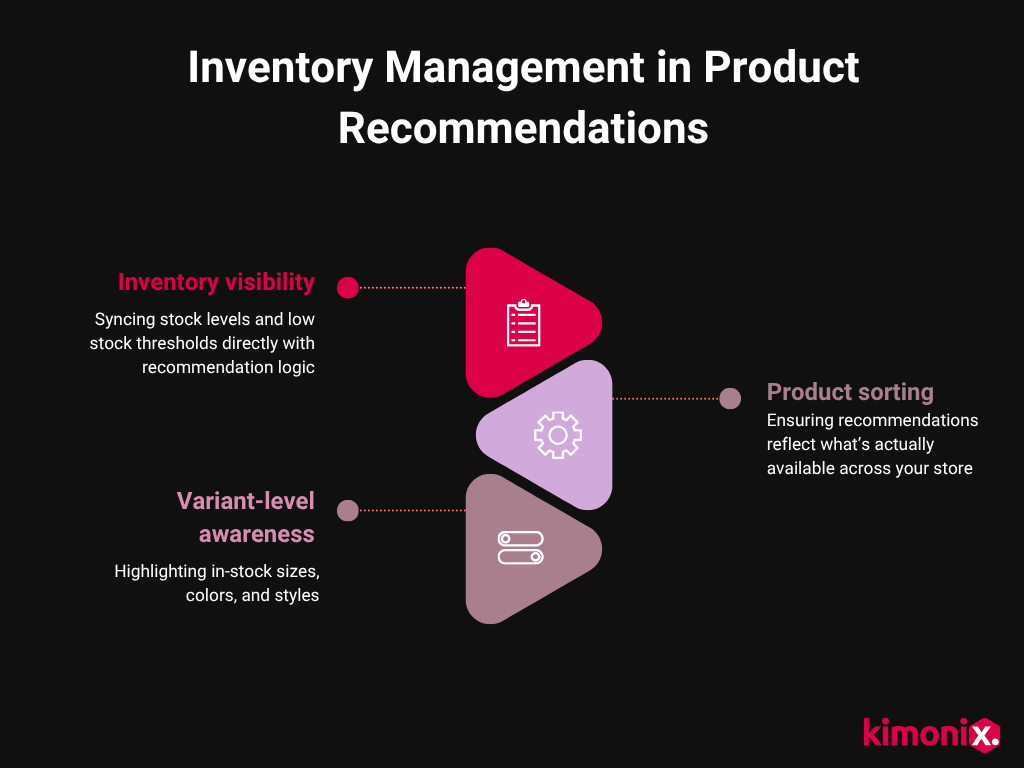
Where Do Low-Stock Product Recommendations Show Up?
Almost everywhere.
If you’re factoring in popularity and behavior without real-time inventory data, then a lot of your recommendation areas on your store are contributing to inventory blindness. Here are just a few!
1. PDPs (Product Detail Pages)
- Like your “You May Also Like” or “Complete the Look” sections
2. Collection pages
- This is because the default Shopify product sort shows top sellers, which are more likely to be out of stock
3. Homepage product carousels
- Like your hero sliders or “Trending Now” sections that are often based on popularity, not inventory
4. Cart and checkout cross-sells
- Such as your “You Might Also Love” or “Add More to Your Order” modules
5. Store search results pages
- Products with limited variants are still likely to appear high in results because of past click/sales data
6. Email campaigns
- Personalized product recommendations or post-purchase upsell emails that don’t factor in inventory levels are more likely to show unavailable variants
7. Pop-up recommendations
- Such as your exit-intent or post-interaction pop-ups
8. Onsite retargeting widgets
- Without real-time inventory data, retargeting widgets often rely on past browsing or popularity to populate
9. Mobile app product feeds
- Apps that mirror basic web logic will surface sold-out or low-stock items in feeds
10. Post-purchase flows
- Such as your order confirmation pages, or follow-up emails with recommendations
Even if a product is technically in stock, if only one size or color is available, its availability for most shoppers is limited. Merchandising logic should factor in stock levels at the variant level across multiple products to avoid promoting low-stock items that can’t convert.
What Happens When You Recommend Products You Can’t Actually Sell?
Product recommendations that have inventory blindness mean your potential customers are clicking sold-out variants.
This is not only super frustrating for shoppers, but means wasted effort from pushing low-availability products on your end. Not to mention poor inventory turnover from surfacing the wrong SKUs and the resulting revenue loss that comes from cut-off shopping journeys.
Let’s look at how each of these outcomes plays a role.
1. Frustrated Shoppers
When customers click on a recommended product and find their preferred size or variant is out of stock, they bounce. This breaks the shopper journey and damages trust in your recommendations.
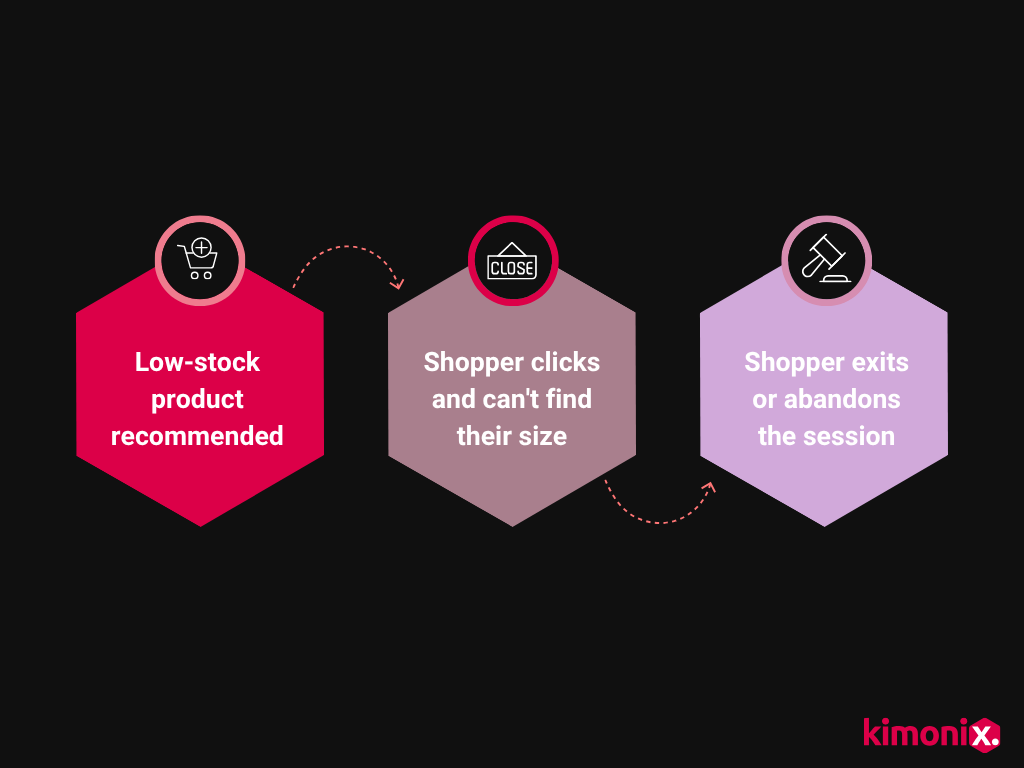
2. Wasted Merchandising and Marketing Spend
A lot of effort (and budget) goes into planning PDP layouts, email campaigns, or homepage modules that recommend just the right product at the right time.
- And if you can’t fulfill the promise of the product you recommend, you’re left with a lot of wasted effort and ad spend without the conversion to match.
In other words, terrible ROIs.
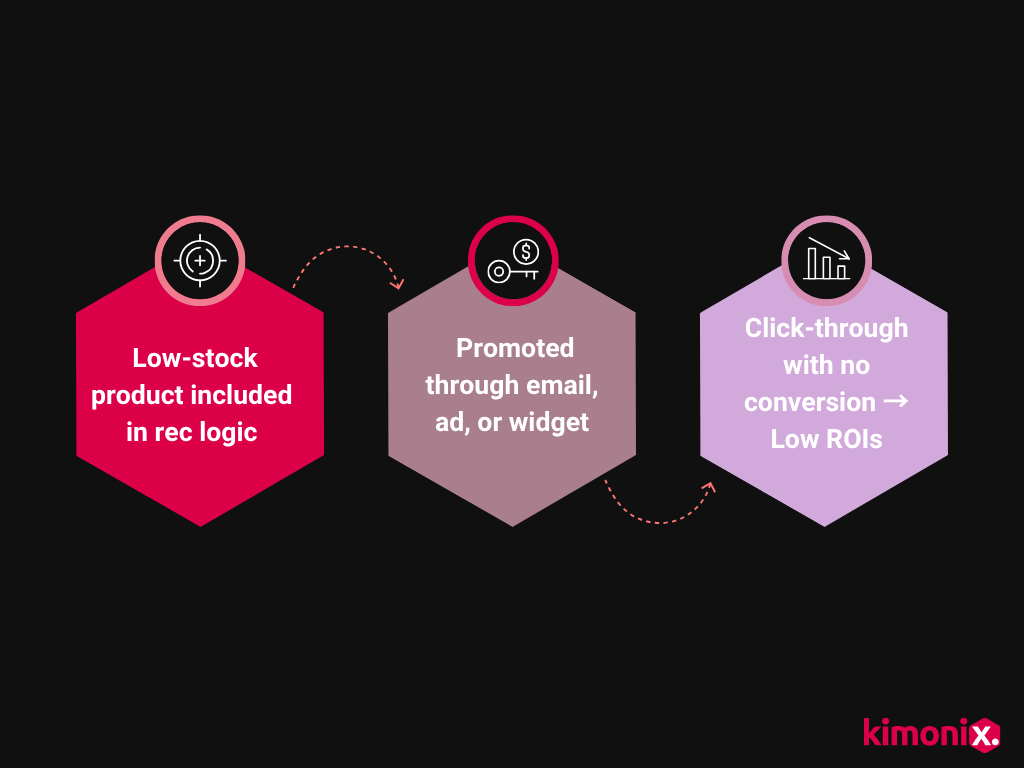
3. Inefficient Inventory Turnover
If your recommendation strategy is relying too heavily on bestsellers and popularity, then it's likely that products with healthy stock levels aren’t being surfaced because the recommendation logic is still prioritizing “popular” low-stock items.
- This slows sell-through rates and increases the risk of having to implement heavy discounting.
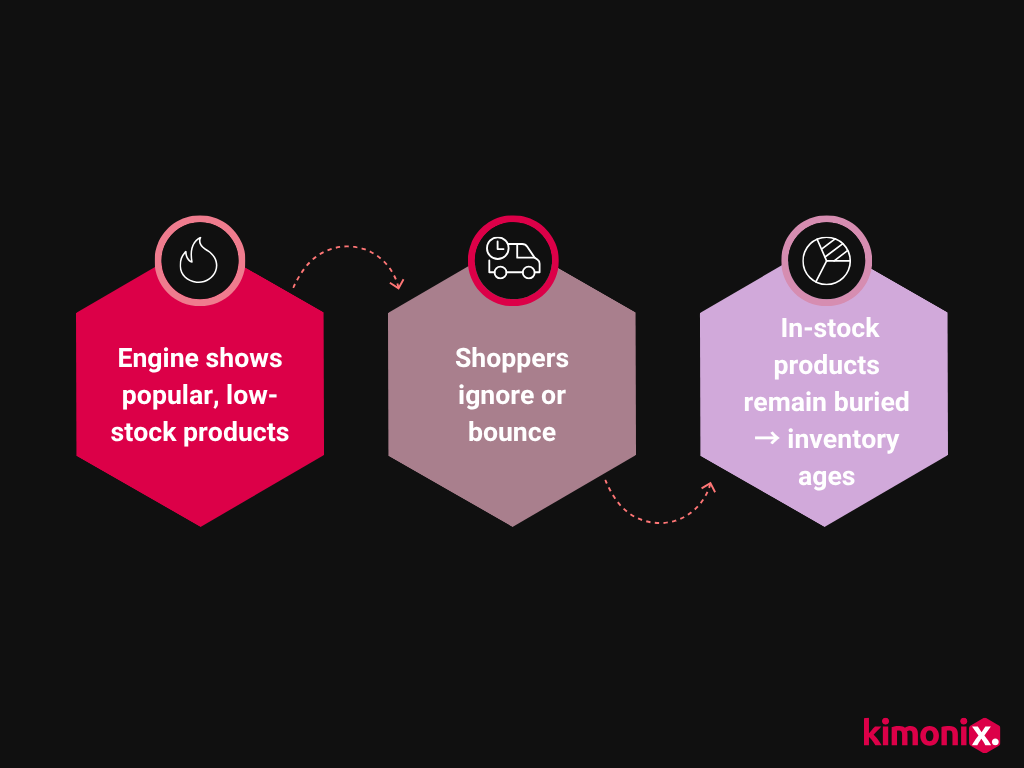
4. Revenue Loss
Every time a shopper clicks on something they can’t really buy, it’s a missed sale.
Multiply that across campaigns, pages, and user sessions, and the compounding loss adds up quickly.
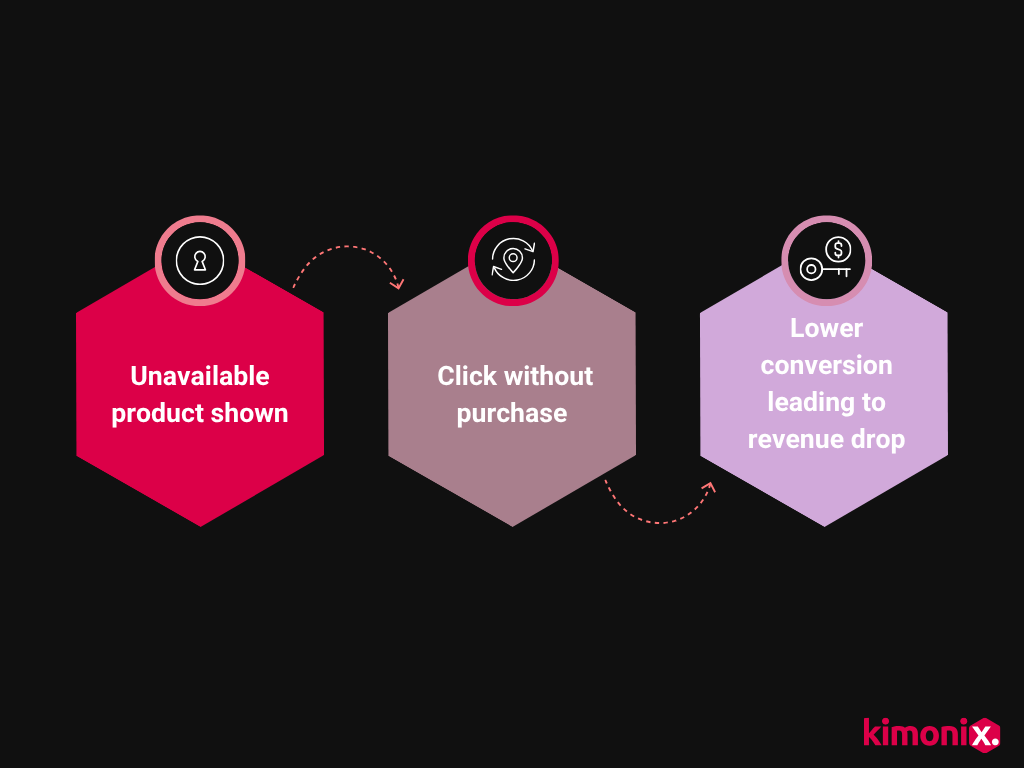
But there is also a hidden, equally costly outcome from product recommendations that don’t factor in important inventory variables in real-time:
- Trust erosion.
Hidden Cost of Dynamic Product Recommendation Engines That Don’t Factor in Real-Time Variants
With every product someone puts in their basket, only to find it’s out of stock by the time they want to check out, you are training potential customers not to trust your store — and your brand.
And if it happens enough in a single shopping session, with first-time potential customers, you could be losing them forever.
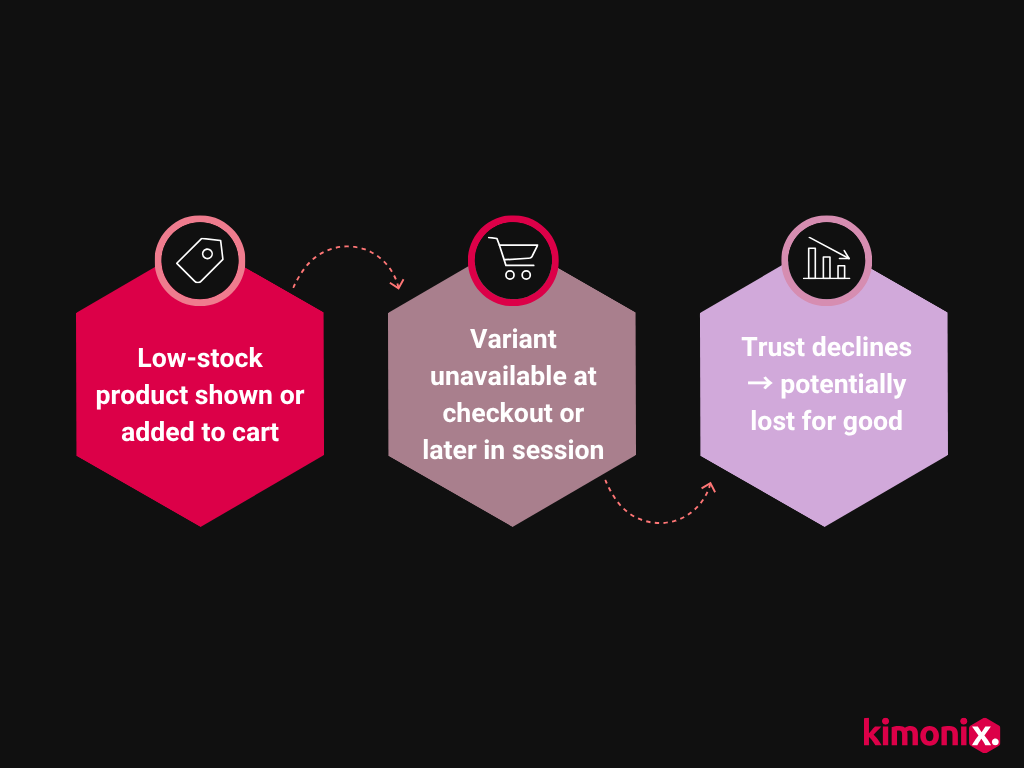
Why Are Most Shopify Recommendation Engines Still Blind to Inventory?
Most product recommendation engines work by analyzing customer behavior, such as:
- What’s been clicked, viewed, or purchased the most
And while that can get your popular products moving, it is definitely not sustainable long-term.
Because what they don’t do well is account for real-time inventory, especially at the variant level. Think:
- Size
- Color
- Style
This means a product could be mostly sold out, but still get recommended just because it was popular in the past.
In many engines, the logic is still disconnected from actual stock. So, a product that once had strong performance stays ranked highly, even when it’s no longer available in meaningful quantities.
- And because those engines aren’t constantly checking live inventory data, low-stock or nearly sold-out products keep showing up — even when they can’t convert.
Note: Why Inventory Alerts Alone Aren’t Enough
Inventory alerts and low-stock notifications help your team stay informed, but they don’t stop low-stock products from showing up in customer-facing recommendations. Unless your merchandising engine actively connects to these alerts in real-time, they won’t impact what your shoppers see.
The bottom line is this:
- You can’t improve conversion until your product logic sees stock clearly, down to the variant. And does so in real-time.
So, how does your merchandising team fix low-stock product display issues?
How to Fix Low-Stock and Inventory-Blind Product Recommendations, Fast
Whether you call them low-stock, inventory-blind, or outdated product recommendations — they frustrate shoppers and drain revenue.
Right now, most retail teams handle this manually. This means constantly updating product recommendations and manually tagging product variants that are low in stock.
And while creating workarounds in Shopify to hide or reorder SKUs and setting thresholds in email platforms to exclude sold-out items is possible, it’s causing a huge resource and time drain.
But, for stores with large categories, this is an even bigger headache, as it’s impossible to scale properly when doing it manually. And even more of a nightmare when:
- They’re (very likely) running multiple campaigns, product drops, or channels all at once
- Their low-stock product recommendations are still slipping through, even with all that effort
The fix?
An engine that does factor in variants!
What Should I Look for in a Shopify Product Recommendation Engine?
So, if we know that doing it manually is unsustainable, switching to a smart recommendation engine becomes inevitable. But not all engines are built to handle the real problem: recommending products that are available to sell.
You want to make sure the AI-powered merchandising engine you invest in is not:
- Inventory blind
- Static
- Variant-ignoring
- Merchandising engine-disconnected
Here’s what to look for if you want to avoid the expensive drawbacks of low-stock product recommendations.
1. Inventory-Aware Logic
The engine should sync with your store’s real-time inventory — and not just at the product level. It needs to consider what’s genuinely in stock right now, so it doesn’t recommend products you can’t fulfill.
2. Dynamic Updates
Look for engines that update in real-time based on inventory changes, sales velocity, and customer behavior, without requiring manual tagging or rule-building. (You want these engines to prioritize recommendations based on in-stock availability.)
3. Variant-Level Sorting
It’s not enough to know a product is “in stock.” You need Shopify engines that sort and prioritize specific variants (like size, color, or style) that are both available and known to convert well. Simply put, you need variant-level logic.
4. Native Integration with Merchandising Logic
The best engines work across collection pages, PDPs, and recommendation blocks — all from the same backend logic.
5. Proven Performance Uplift
Bonus if it’s already delivering results for other stores — like increased conversion rates, improved inventory turnover, and lower bounce from sold-out product clicks.
Just like Kimonix!
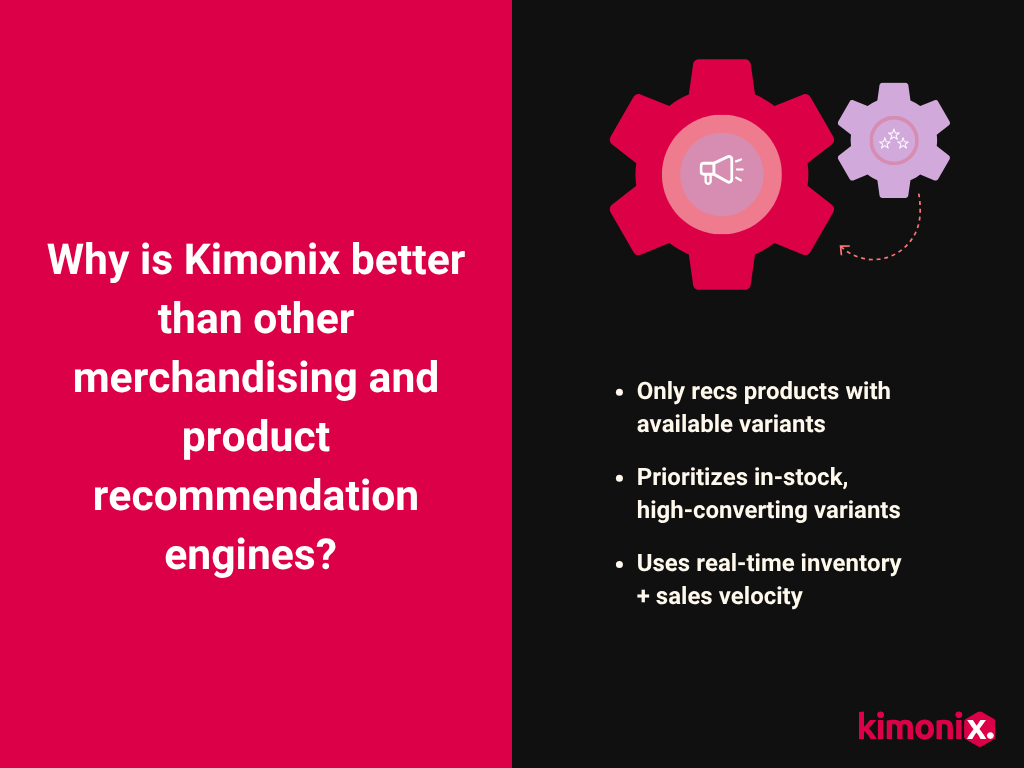
Bonus Content: Kimonix vs. Nosto
How Kimonix Automatically Solves the Low-Stock Product Recommendation Problem
Kimonix’s new Variants with Stock feature removes the need for manual tagging, rules, or storefront workarounds. It does the job your merchandising team would never have time for — automatically, and at scale.
Here’s how it works:
1. It dynamically prioritizes in-stock, high-performing variants.
- So, instead of showing products with mostly sold-out options, it surfaces the ones that have real inventory, especially in top-selling sizes or colors.
2. It works across your entire store.
- On collection pages, product recommendations, and even on PDP variant dropdowns, Kimonix uses real-time inventory data to push available options forward.
3. It directly improves store performance.
- By only recommending products available for buying, it reduces bounce rates, increases conversion, and improves inventory turnover.
4. It requires zero manual effort.
- No tagging. No storefront edits. No new logic to build or test. The engine runs in the background using your live inventory, sales velocity, and customer behavior data to update recommendations in real-time.
And the results?
Early users saw up to a 17% lift in conversion rates — without changing a single thing on the frontend! But don’t just take our word for it:
- According to Vervaunt, implementing real-time, inventory-aware product recommendations can boost conversion rates by up to 15%, as it minimizes customer frustration from encountering out-of-stock items.
Want to see how the Kimonix merchandising and product recommendation engine works, for free?
How Merchandising Teams Can Put Inventory-Aware Recommendations to Work
Even with a smart engine, it matters how your team uses it day to day. Here’s how Shopify retailers are using inventory-aware logic in real workflows:
1. During product drops or new launches
- Let your recommendation engine automatically push down products that are already running low after the initial launch surge. That way, you're not still promoting something that’s mostly sold out.
2. When planning seasonal updates
- Use variant-level inventory logic to hide sizes or colors that aren’t relevant anymore — even if they’re technically still in stock.
3. In email or SMS campaigns
- Instead of manually excluding sold-out products in Klaviyo or Omnisend, pull in personal email recommendations directly from your engine.
4. For sales and clearance events
- Focus on products that still have a good number of in-stock variants. That keeps customers from landing on styles that are already picked over.
5. In weekly merchandising meetings
- Look at what’s being recommended versus what’s actually in stock. This helps catch products that aren’t getting visibility, even though they have strong stock levels and potential.
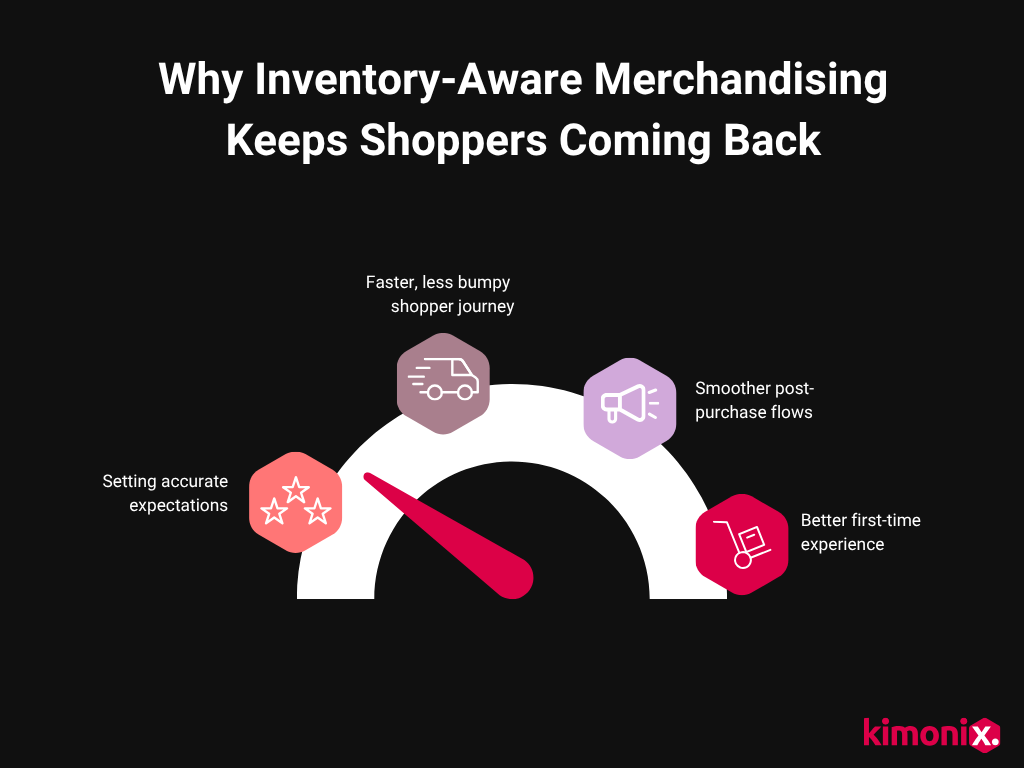
How to Fix Low-Stock Product Recommendations on Shopify
Before you invest in fixing low-stock product recommendations, take a minute to assess where your store stands. Ask yourself these four questions:
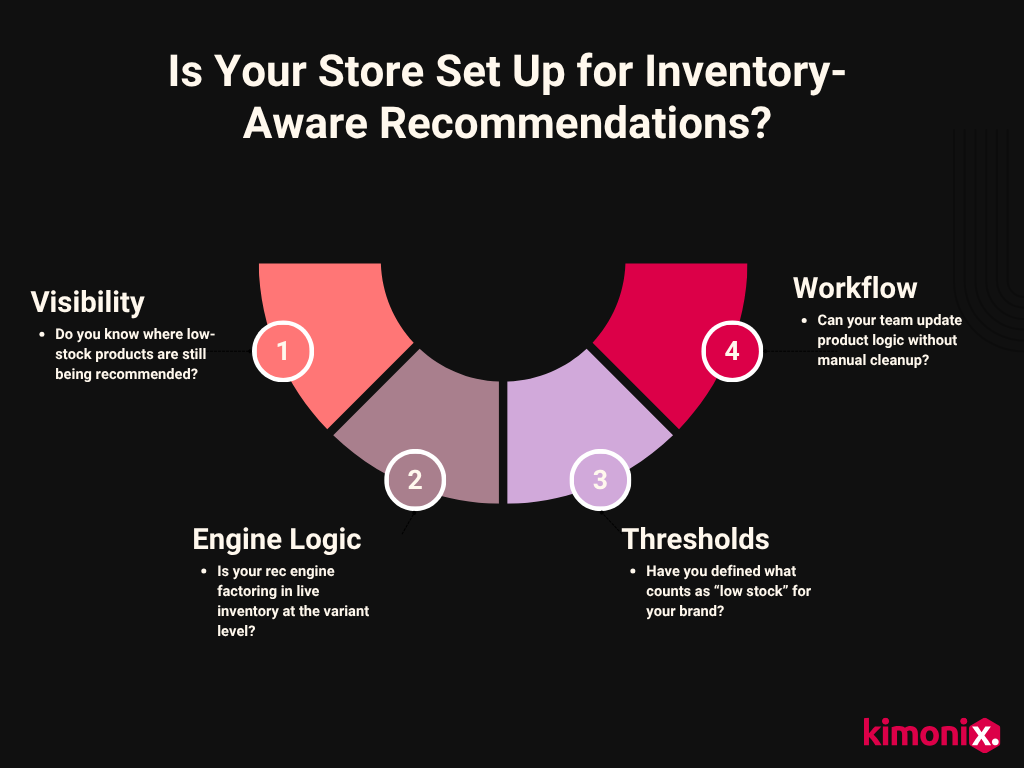
And then follow these steps:
Step 1: Spot Where Low-Stock Products Are Still Showing
Audit your PDPs, product carousels, email campaigns, and search results to find where low-stock products or variants are being recommended, especially those that don’t meet your low-stock threshold.
Step 2: Check Your Recommendation Engine
Review your setup to see if it factors in inventory level, stock quantity, and variant availability in real-time, and check if it’s still running off outdated logic.
Step 3: Set Your Low-Stock Threshold
Decide what counts as “low inventory” for your brand. This could mean fewer than 3 units per variant, or only 1–2 sizes left in stock. Define your low-stock level based on how your customers shop.
Step 4: Use an Inventory-Aware Engine
Switch to a tool (like Kimonix) that dynamically adjusts based on real-time stock levels and keeps recommendations aligned with actual product availability — no manual work or low-stock notifications needed.
Step 5: Monitor and Adjust
Track your low-stock reports, bounce rates, conversions, and sell-through. If you're on Shopify Plus, make sure your Shopify app stack works well with your recommendation engine and existing inventory management tools.
And that’s a wrap! Well, almost…
TL; DR: How Can You Improve Low-Stock Product Recommendations Without Manual Merchandising?
Manual tagging and one-off fixes don’t scale, and they still let low-stock items slip through. The fix? Using a real-time product recommendation engine that sees your inventory clearly (down to the variant) and updates dynamically.
Kimonix’s “Variants with Stock” feature handles this automatically by promoting what’s available and pushing low-stock products out of focus. It works across PDPs, collections, and recommendation areas without any extra setup.
If you’re still recommending products you can’t sell, it’s not just costing you sales — it’s costing you trust.
A fix like this should be standard in 2025 and beyond.
Low-Stock Product Recommendation FAQs
1. How do low-stock alerts help prevent conversion issues?
Low-stock alerts help internal teams know when a product is running low, but they don’t automatically change what’s recommended to customers. You need an AI-merchandising app that uses this data to hide or reorder low-stock items in real-time.
2. Can I adjust low-stock thresholds for product recommendations?
In some systems, yes. But it usually requires manual setup. Merchandising and product recommendation engines like Kimonix factor in low-stock thresholds automatically, removing the need for constant rule adjustments.
3. What’s the connection between inventory levels and customer satisfaction?
Shoppers expect to find what they click on. If they’re frequently led to unavailable items, customer satisfaction drops — and so does trust in your store’s product recommendations.
4. How does customer demand connect to inventory-based recommendations?
Smart merchandising uses both customer demand and inventory data. That means surfacing in-stock items with high purchase intent, not just popular items that are nearly gone.
5. What’s the benefit of running a low-stock report regularly?
Running a low-stock report can help you identify products at risk, but if your recommendation engine doesn’t factor that data in, shoppers may still be seeing items that are already unavailable.
6. Do I need a low-stock notification app to fix product recommendations?
Low-stock notifications can help your team stay on top of inventory changes, but they won’t fix recommendation issues on their own. You need an engine that actively pulls real-time stock levels into its logic.
7. What is a low-stock threshold, and how does it affect inventory-aware product recommendations?
A low-stock threshold is the minimum quantity at which a product is considered ‘nearly out.’ If your recommendation engine doesn’t account for this, it may keep promoting products that are no longer reliably in stock.
8. How do stock levels and inventory levels influence what gets recommended?
Product recommendation logic should prioritize inventory level, not just historical popularity. Engines that skip this step often surface low-stock products, which frustrates shoppers and reduces conversions.
9. Can a low-stock notifier prevent poor product recommendations?
Not directly. A low-stock notifier alerts internal teams, but it doesn’t change what gets shown to shoppers unless it’s tied into a smart merchandising engine.
10. How does stock quantity impact conversion rates on Shopify stores?
If you recommend products with low-stock quantity (especially in popular variants), customers are more likely to bounce or abandon your store entirely when they can’t find what they want.
11. Is there a Shopify app that helps fix low-stock product recommendations?
Yes! Kimonix is a Shopify app designed to make your recommendations inventory-aware. It works across product pages, collections, and campaigns without requiring manual tagging or stock-based rule building. You can find out more about the Shopify app here.
12. Does this also work with Shopify Plus stores?
Kimonix works seamlessly with both Shopify and Shopify Plus stores. Large catalogs and advanced workflows benefit even more from automated, inventory-aware recommendation logic.
13. How does Kimonix handle low-stock product recommendations across Shopify themes and apps?
Kimonix works in the background of your existing Shopify theme and integrates without disrupting your design or app stack. There’s no need to install a separate low-stock alert app or manually update product settings.
14. Can I use API documentation to sync product availability across my online store?
It’s possible, but often complex. Kimonix handles this dynamically without needing custom API connections, automatically pulling real-time inventory data.
Social Media
Recent Posts





